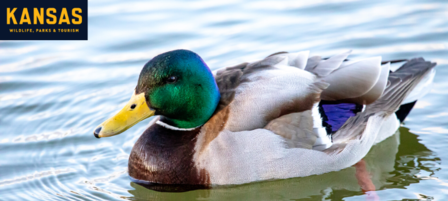Increased Pressure on Public Waterfowl Hunting Areas Discussed at Wildlife, Parks and Tourism Commission Meeting

PRATT –At the March 25, 2021 public meeting, Kansas Wildlife, Parks and Tourism Commissioners discussed issues raised by Kansas waterfowl hunters about the increase in nonresident waterfowl hunters during the 2020-2021 season. At the request of commissioners, Tom Bidrowski, Kansas Department of Wildlife, Parks and Tourism (KDWPT) migratory gamebird program manager, presented data on the number of resident versus nonresident hunters on public waterfowl hunting areas. According to Kansas Duck State Waterfowl Permit sales, non-residents made up 38 percent of Kansas waterfowl hunters last season – up from 21 percent in 2011. However, that ratio varies, depending on the wildlife area.
Several commissioners pushed for a solution to the problem before the upcoming season. Possible solutions discussed include limiting the number of days non-residents can hunt waterfowl at some Kansas public areas and/or limiting the number of non-residents on such areas via a lottery drawing. The topic will see more discussion at the commission’s April 29 meeting.
Other items of note addressed during the March 25 meeting:
Season dates, limits for 2021-2022 waterfowl seasons.
Bidrowoski presented proposed season dates and limits for upcoming duck and goose seasons. The proposed dates and limits follow a similar framework of recent seasons and go to a vote at the April 29 meeting.
An exception could be the weekend before regular duck seasons open, when youth, people with disabilities, veterans and active military are allowed to hunt. Commissioners discussed changes that could reduce conflicts and ensure youth experience high-quality hunts.
Increased opportunities for youth, parents
KDWPT staff and commissioners continued discussion about raising the maximum age of youth participating in youth seasons to 17. Currently, the maximum age is 16 for pheasant, quail, turkey and deer youth seasons, but 15 for waterfowl youth seasons. The change being considered is meant to increase opportunity and make regulations consistent.
Another recommendation will remove the requirement that adults accompanying youth hunters during the youth waterfowl season be licensed and have appropriate stamps. Again, the goal is to increase opportunities for youth and simplify regulations.
Jeff Prendergast, KDWPT small game specialist, recommended allowing youth hunters to take full bag limits of pheasant (four roosters per day) and quail (eight per day) during the youth weekend. Currently, youth season daily bag limits are half those allowed during the regular pheasant and quail seasons.
Continuous prairie chicken season
Kent Fricke, KDWPT small game program coordinator, presented staff recommendations to run the 2021-22 greater prairie chicken season from Sept. 15 through Jan. 31. Previously, the season has ran from Sept. 15 through Oct. 15, and the third Saturday of November through Jan. 31.
The early season segment, when hunters typically hunt greater prairie chickens with dogs, has gained in popularity and this change would increase those opportunities. Research shows hunters annually harvest no more than 3 percent of the Kansas greater prairie chicken population, so eliminating the split is not expected to have any impact on prairie chicken populations. Fricke said northcentral Kansas, where greater prairie chicken numbers remain strong, receives the most hunting pressure.
State park kiosks
Linda Lanterman, KDWPT Parks Division director, updated the commission on the plans to install electronic kiosks in designated Kansas state parks this year. The kiosks will allow park users to purchase permits with credit cards, replacing the cumbersome and inefficient unmanned “Iron Rangers,” which require cash deposits. The kiosks will provide users a receipt that can be placed on the dash of their vehicle.
Improving commission/public communications
Nadia Reimer, KDWPT chief of Public Affairs, presented plans to improve communications between the public, commissioners and department staff by creating a central webpage for that purpose. The new page will provide a place for the public to submit questions, ensure that all public questions are answered and make it easier for the public to request topics for discussion at future commission meetings.
Pronghorn permit reduction
Citing several years of poor reproduction, Matt Peek, KDWPT wildlife research biologist, indicated a 20 percent reduction in firearm and muzzleloader permit quotas will be recommended for this fall. Peek also mentioned that staff are considering a change for the 2022 application process that would prohibit hunters who purchase an over-the-counter archery permit from also purchasing a firearm preference point. Archery season hunting pressure increased significantly since that option has been allowed.
Big game clothing requirement change
Levi Jaster, KDWPT big game program coordinator, introduced a request to modify the state’s requirement for wearing of “hunter orange” while hunting deer and elk during a firearm season.
The proposal would allow hunters to wear an orange “garment” on their head instead of a hat, as the regulation now requires. The addition would allow the use of garments like thick headbands for those with hairstyles that make wearing traditional caps and hats difficult.
Deer hunting permit numbers
Commissioners voted to approve season dates for 2021-22 deer seasons, which largely resemble recent seasons.
Jaster informed commissioners of quotas set for non-resident deer and resident firearm either-species permits for the 2021 seasons. Overall numbers are similar to 2020, with a modest reduction in permits that allow the taking of a mule deer.
Virtual meeting continuation
Commissioners decided the April 29 commission meeting will be virtual because of COVID-19 concerns. It was originally to be held in-person in Beloit.
Gerald Lauber, commission chairman, praised the success of the current virtual format, which allows the public to participate through Zoom or watch on YouTube.
For more information on future and past commission meetings, visit https://ksoutdoors.com/KDWPT-Info/Commission.
###









